
Staff
Erin Wright, editor Contributing Writers; N.S Nokkentved, Amy Cross, Ken Bennett, Tom McBride, Rich Royston, Jim Wiggins, Mike Monson Photography; N.S. Nokkentved
Adviser; Lynn Robbins
Cover design and photographs by N.S. Nokkentved
 TheMonthly Planet is published bi-quarterly by the Associated Students Environmental Center at Western Washington University, Bellingham, WA.
TheMonthly Planet is published bi-quarterly by the Associated Students Environmental Center at Western Washington University, Bellingham, WA.

MONTHLY PLANET DECEMBER 1987 A publication of the A.S. Environmental Center, Western Washington University volume IX number ii December 1987 G-P, chlorine and Bellingham, page 4 C 0 N T E N T s Georgia-Pacific By Amy M. Cross Noisy Creek Old Growth threatened By N.S. Nokkentved Black Bears By Tom McBride Profile; Bruce Brown By Ken Bennett Chiaro-fluorocarbons By Jim Wiggins Fall spawning runs By Mike Monson Wildlife endangered by lack of rain By Rich Royston Endangered Species By S. P. R. Charter Briefs December 1987 4 6 10 12 14 15 16 18 22 Noisy Creek logging, page 6 733-1669 1221 Railroad Ave. FILM DEVELOPING, DARKROOM SUPPLIES, COMPLETE SERVICE FOR SERIOUS PHOTOGRAPHERS 1,. ~s~e ~~a,mg,Jnt. 901 W HOLLY T BELLINGHAM. WA 98225 733-5461 Patagonia Sierra Designs Trak Asolo Rentals Available BACKCOUNTRY OUTFITTERS 3
ORGIA-
Chlorine 1n Bellingham
By Amy M. Cross
An accidental gas leak on Oct. 19, at the Georgia-Pacific (G-P) Bellingham plant covered downtown with a greenish-.yellow cloud of chlorine and iron chloride. As a result, a series of changes are unfolding for Bellingham's emergency information and evacuation procedure.

"We have reviewed our current emergency information procedure and we have come up with a few new changes," Mayor Tim Douglas said.
"People wanted to know how they would receive notification of a disasterous situation if one were to arise again. Many parents called us and were rightfully concerened about where their children were. Parents wanted to know what role the schools have during an emergency and how they will know if someone is watching out for the safety of their children," Douglas said.
In response to the community's concerns for how and when people will be informed of future emergencies, G-P and city officials have prepared a suggested outline for changes and additions to Bellingham's emergency notification system.
Prior to the recent emergency, testing of the warning sirens and the emergency broadcast system were independent of one another, Douglas said. City officials plan to bring these two systems together If people hear sirens now, they can tune to KGMl-790 A.M. for emergency information and evacuation procedures.
"There were numerous concerns as to why the sirens were not sounded. We decided not to use them because people would have heard the sounding alarm and possible reacted by running outside of their houses and maybe
CIFIC,
4
Monthly Planet
Tank-cars are frequent visitors at G-P's Bellingham plant.
attempting evacuating the area by car. We wanted to prevent hysteria; we needed people to remain inside, shut their windows and turn off ventalation systems," Douglas said.
Fire Chief Jay Gunsals said the Bellingahm Fire Department learned a few lessons during this incident. Messages concerning evacuation were mixed, he said. Police officers and building owners were telling people to leave buildings, and G-P officials and the fire department were telling people to remain indoors, away from the gas. In addition, the fire department learned that it should have provided Seattle radio and television stations with appropriate emergency response information. The information would have reached Bellingham residents watching or listening to some of those Seattle stations.
"We believe the combination of sirens and a radio message will alleviate most of this confusion, if an emergency requiring evacuation were to arise again." Gunsals said.
City officials want to install a computer system that automatically will alert hospitals, schools, transit systems and other public facilities, that might need immediate notification of an emergency or catastrophe. In addition, plans include a back-up system for the 9-1-1 emergency telephone system. If the people working the 9-1-1 system should ever have to evacuate their headquarters in the basement of the Whatcom County Courthouse, a computerized system would start answering calls and relaying messages.
Bellingham officials also realized the need for a coordinated and common gridding system for the town. Gunsals pointed out that all city agencies need to have gridding system that they all are familiar with. This would require coordinated efforts from the fire department, police department, public transit and other public service departments.
"For example, if the fire department needs a section of town blocked off during an emergency procedure, it is essential that when we ask them to section off a specific quadrant, we all have the same area in mind." Gunsals said
"The fire department conducts at least three of four informal familiarization inspections yearly. These sessions are extremely useful for pre-incident planning. We note the locations of the fire hydrants, the sprinkler system within and the size and complexity of the plant. We set up a designated area were initial communication of the nature of the emergency will take place. In this last incident, the contact person from Georgia Pacific met us as planned at the main guard gate on the east side of the plant," Gunsals said.
In the spring of 1987, the fire department made a special point of requiring every engine company go through the familiarization session at G-P. Bellingham has five stations, and each station has three engine companies. A total of eighteen companies were educated for pre-incident planning. In addition to the pre-incident planning at G-P, the fire department conducted a three-day tank car accident drill at G-P's north terminal in August.
"A chlorine leak in our town is the event so many people have been wringing their hands about for years in this town and Georgia Pacific and the fire department proved to the people of our community that we could control a leak of
approximately 55 gallons of chlorine gas," Gunsals said. The fire department depends a great deal on the expertise of the people who work with the chemical products everyday, Gunsals said. It specifically depends upon G-P's safety people to inform the department about what is going on, what chemicals are mixing together, and what reactions to expect.

"I think we need to inform the public of what to expect and what to do in case of an emergency like this one we just had at Georgia Pacific," Gunsals said.
"I wanted to know how well our emergency services responded and what type of state review would be necessary. I think the people of Bellingham have a right to know about Georgia Pacific's safety. I want to use the services of Washington State's Department of Ecology, and the Department of Labor and Industry. These two organizations will provide me with the level of competency I want to give this community," Douglas said.
lnvestigater Cullen Stephenson, from the industrial section of the Department of Ecology (DOE}, said the DOE is interested in preventing a similar incident at G-P. The DOE has asked G-P to work on engineering changes of the vaporising facilities, and expects G-P will complete them by the end of November.
Mayor Douglas said the Department of Labor and Industry is looking into G-P's entire plant operations and the general working condition. This analysis includes information on industrial hygiene, safety practices, equipment performance, air quality in the work place, safety records, complaints and the plants operation levels.
"There is a lot of anxiety within our community from having chemicals like chlorine produced within the city. But let us not stray from the real issue, we need to focus
December 1987
chlorine leak in our town is the event so many people have been wringing their hands about for years ... '
(continued on page 18) 5
-Jay Gunsals
Old Growth threatened
By N.S. Nokkentved

The eastern shore of Baker Lake rises suddenly out of the water for one thousand feet or more. The steep slopes are covered with ancient Douglas-fir, Western red cedar and Western hemlock. To the northwest, Mt. Baker presides over this area of scenic splendor.
Baker Lake is a rarity in Washington. Its shores are not lined with hotels or summer homes or luxury condominiums. In fact, the southern shore is mostly virgin old-growth forest. It is a prime recreation area. Except for two private land owners, Scott Paper Company and Puget Power, the lake belongs to the people of the state.
6
Baker Lake Resort overlooks the north end of the lake.
Monthly Planet
The Department of Natural Resources (DNR) recently granted Scott a permit to clearcut 160 acres of its 629 acres located between Noisy Creek and Silver Creek on the southern shore of Baker Lake. The area borders the Mt. Baker-Snoqualmie National Forest and the Noisy-Diobsud Wilderness.
This old forest is home to bald eagles, ospreys, spotted owls and countless other species including, possibly, grey wolves and grizzly bears. It is rare to find such a large unbroken stand of old-growth timber at such low elevation. The normal level of Baker lake is 724 feat above sea level. Most of the remaining old-growth in the Northwest, not included in wilderness, is above 2,000 feet and most is not easily accessible.
The remoteness of the Noisy Creek area has been the salvation of these big trees--so far. In 1959 the newly completed Puget Power dam transformed the former 750 acre lake and the Baker River valley into the present 10-mile long, 5,000 acre Baker Lake. In the process a forest service road and bridge across the river were covered by many feet of water cutting off access to Scott's property.
Prior to the raising of the lake Scott, which had purchased the land from Sound View Pulp and Timber only a few years before, was allowed time to cut timber that would otherwise be flooded. Scott also clearcut a 70 acre patch on the slope that is now the lakeshore. This cut is visible today as a patch of 30-year old alders.
In the early 70s Scott approached the forest service to get access to their land. Scott hoped to build a road around the north end of the lake, utilizing a partially finished bridge across the river there. The forest supervisor at the time, Jim Torrence who now is the head of Region 6 of the U.S. Forest Service, was not in favor of building the road nor of logging the steep slopes. He suggested a land trade instead.
The first talk of a land trade began in 1967. It did not succeed then, and it did not succeed in the 70s. In a land trade with the forest service Scott would get a piece of forest service land containing an equal value of timber. In 1981 a piece of land in Snohomish County was agreed upon, but the trade ran aground on public opposition to logging in the proposed trade area.
A land trade, however, still is a possibility.
"We don't consider it out of the
question," Scott spokesman Rollie Harris said. In fact, negotiations to work out a trade are currently in progress, but with no specific piece of land in mind.
In order to gain access to the other side of the lake, Scott proposes to barge trucks, timber and equipment across the lake. Ramps to accomodate the barge would be built on both sides of the lake. On the north side the ramp would be built on the existing remnant of the inundated road, and on the south side, a new ramp would be built. The ramps would consist of large fill rock mainly to provide traction for the trucks.

The DNR and the forest service feel the barge would be the least environmentally damaging way of gaining access to Scott's land.
"It's our preferred alternative," Chuck Raddon of the forest service said.
The barge would make about 12 round-trips per day, Scott lawyer Dan Zender said. The barge can carry two trucks per trip, and it will take about two years to log the 160 acres, he said at a recent public hearing on a Whatcom County shoreline development permit required to build the ramps.
In a statement addressed to Charles Snyder, Whatcom County hearing examiner, the Friends of Noisy Creek, a committee of the North Cascades Chapter of the Audubon Society, claims the barge operation would violate state
and county shoreline management regulations.
"It is clear that public uses, long term benefits, preservation of the natural character and ecology of the shorelines, and increasing public access and recreational use, are preferred over uses which benefit a private party, provide a short term benefit, and degrade the shoreline's environment," the statement claims.
Baker lake is designated as a shoreline of state-wide significance and as such is entitled to special consideration. Section 4.3 of the Shoreline Management Program states, "The state-wide interest should be protected over the local interest; the natural shoreline character should be preserved; uses should result in long term benefits to people of the state; resources and ecosystems should be protected."
Section 4.3.c of the law states, "Potential short term economic gains or convenience should be measured against potential long term and/or costly impairment of natural features."
Friends of Noisy Creek and other opponents claim the barging operation and the clearcutting on the slopes above the shoreline is a direct violation of this section.
"Is it in our interest that logs be barged across beautiful Baker Lake?"
Indian Pipes growth on the moist, shady forest floor.
7
Mitch Friedman of Shuksan Earth First! asked at the hearing. Gregg Mills, Skagit County representative of the Friends of Noisy Creek, referred to the barge operation as an "industrial intrusion" into a prime recreation area.
"We feel it'll be a hell of an impact on the view," Ed Lemos, one of the owners of the Baker Lake resort said of the proposed logging. More than 60,000 people from all over the world visit the resort, across the lake from the Scott land, during the season from April through October, he said.
"If others think this is a treasure, maybe we should look at it a little closer," Lemos said.

In the meantime, however, the Sierra Legal Defense Fund has filed an appeal on Scott's DNR permit in behalf of the Sierra Club and the Audubon Society. A hearing is scheduled in March of next year in Olympia.
The DNR, after reviewing an environmental checklist submitted with Scott's permit application, determined the potential for environmental damage was not significant enough to require an environmental impact statement, a part of the State Environmental Policy Act.
"We feel the proposal Scott has put forth will not harm the environment, if they follow the guidelines in their proposal and proper forest practices," DNR forester Dick Skvorak said in an interview this summer.
The appeal was filed because the environmental checklist was inadequate, and the project requires a full environmental impact statement, Todd True, a lawyer for the Defense Fund said.
"We believe there will be a significant environmental effect from this proposed clearcut," True said. Those effects include deterioration of water quality from road construction and clearcutting a "highly erosion prone" slope, and destruction of wildlife habitat.
Since a disasterous debris flow, or mud flow, into Lake Whatcom in 1983, geologists and soil scientists have taken a new look at the effects of road building and clearcutting on steep or unstable slopes. When the vegetation that normally stabilizes the soil and retains rainfall and runoff is removed in steep terrain, a period of intense rainfall may trigger a slide of surface material. The flow is a dense, viscous combination of mud, rocks and surface debris.
Parts of the slope on the Scott property has been described as steep
8
Larry Williams (left) and Frank Ancock measure this Douglasfir at 34 1/2 feet in circumference.
and unstable by the forest service and the DNA. Harris said Scott's plan is to avoid areas of potential environmental damage, including bald eagle nesting areas and excessible steep portions of the slope.
said. Other experts disagree on the amount of old-growth necessary to preserve the spotted owl. The number of acres varies for 2 ,000 to nearly 7,000.
Tom Campion, an old-growth specialist with the Seattle Audubon Society , called the trees in the Noisy Creek area "the best spotted owl habitat I've ever seen. It is extremely rare to see such a large stand of such large trees."
One of the largest in the area is a Douglas-fir measuring 34 1/2 feet in circumference five feet above its base
-Tom Campion
Some proponents of clearcutting claim the open areas it creates benefit game. But, it is the edge of the clearcut, the transition from forest to open space, that is beneficial to some wildlife species. The openings let sunlight into the forest understory increasing growth of shrubs and berry bushes, which provide forage for species such as deer and bear. The rest of the open areas provide too little cover to be much benefit.
Grizzlies are more affected by human activity than by clearcut areas, Radden said.
The open areas, however , are a hazard to other species. The spotted owl evolved in the dense old-growth forests. It is a slow but highly maneuverable flier easily able to elude larger predator birds amongst the trunks of the large trees. In the open the spotted owl is no match for its predators.
Because of its dependence on old-growth forest, the spotted owl has been designated as an indicator species by the forest service. The well-being of the owl is used to guage the health of old-growth forests. But, it is by no means the only species dependent on old-growth. More than 70 species of plants and animals depend for their survival on the health of the rapidly diminishing old-growth forests.
Old-growth, a vital storehouse of genetic diversity, now accounts for less than 10 percent of the forest in the Northwest. If Scott were to log all of its 629 acres, the Noisy Creek area would become worthless as spotted owl habitat, conservationist Rick McGuire
To Scott, the world's number one producer of tissue products, these trees represent a valuable resource to be harvested. Harris said Scott eventually plans to log the entire 629 acres, and most of the logs are destined for export where old-growth logs are worth several times their domestic value.
Logging the area is part of a plan to log a "sustained balance" of second-growth and old-growth timber and to bring Scott a return on its investments, Harris said.
"There is a valid authorization to remove the timber at this time," Zender said. The appeal process does not include an automatic stay, but Scott voluntarily has agreed to hold off logging until the appeal process is completed.
"It's revokable by us at anytime , as far as I'm concerned," Zender said.
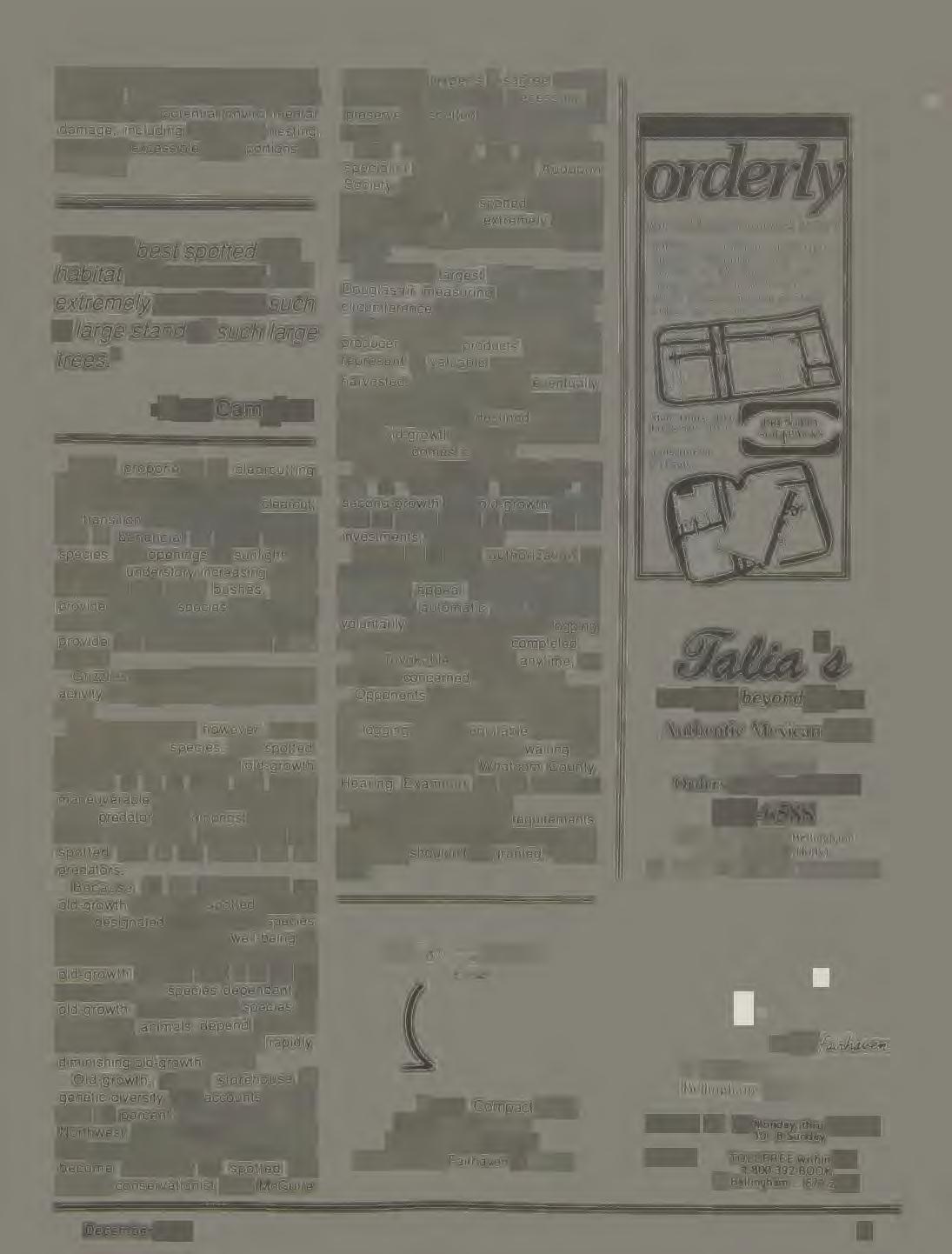
Opponents to the logging hope Scott will realize the value of the land and hold off logging until an equitable trade can be worked out. Scott still is waiting the final word from the Whatcom County Hearing Examiner on the shoreline permit for the barge ramps.
"We have fullfilled all the requirements under state law. We see no reason why the permit shouldn't be granted," Harris said.
'
It's the best spotted owl habitat I've ever seen. It is extremely rare to see such a large stand of such large trees.'
December 1987
1f'lro@
©!l 'if~t ecords Tapes Compact Discs Music For All Times Open 7 Days A Week 1307 11 St. In Fairhaven 647 -1307 orderly for w il de rn ess , town & trave l Organize yo u r notes and papers in o n e of Brentley's soft organizers. We have several styles and systems to choose from, w hatever yo u r "portable office" needs a re. one step beyond flavor Authentic Mexican Food Try our o rig inal , fresh tomato salsa Orders to Go or Dine In 671-6588 1222 " A" N Garden, Bellingham (comer Garden & Holly ) M - Th 11-9 • Fri & Sat 11 - 10 Oosed Sun 12 IO I Ith t Bellm gharn WA ~822,HOURS: 10 · 10 Monday thru Saturday 10 · 6 Sunday PHONE : TOLl:FREE within WA 1-800-392-BOOK In Bellingham • 671-2626 9
OO~lril~
Black bears are vegetarians and feed on fruits and berries, but a few prefer the sweet inner bark of young trees.
BLACK
BEARS
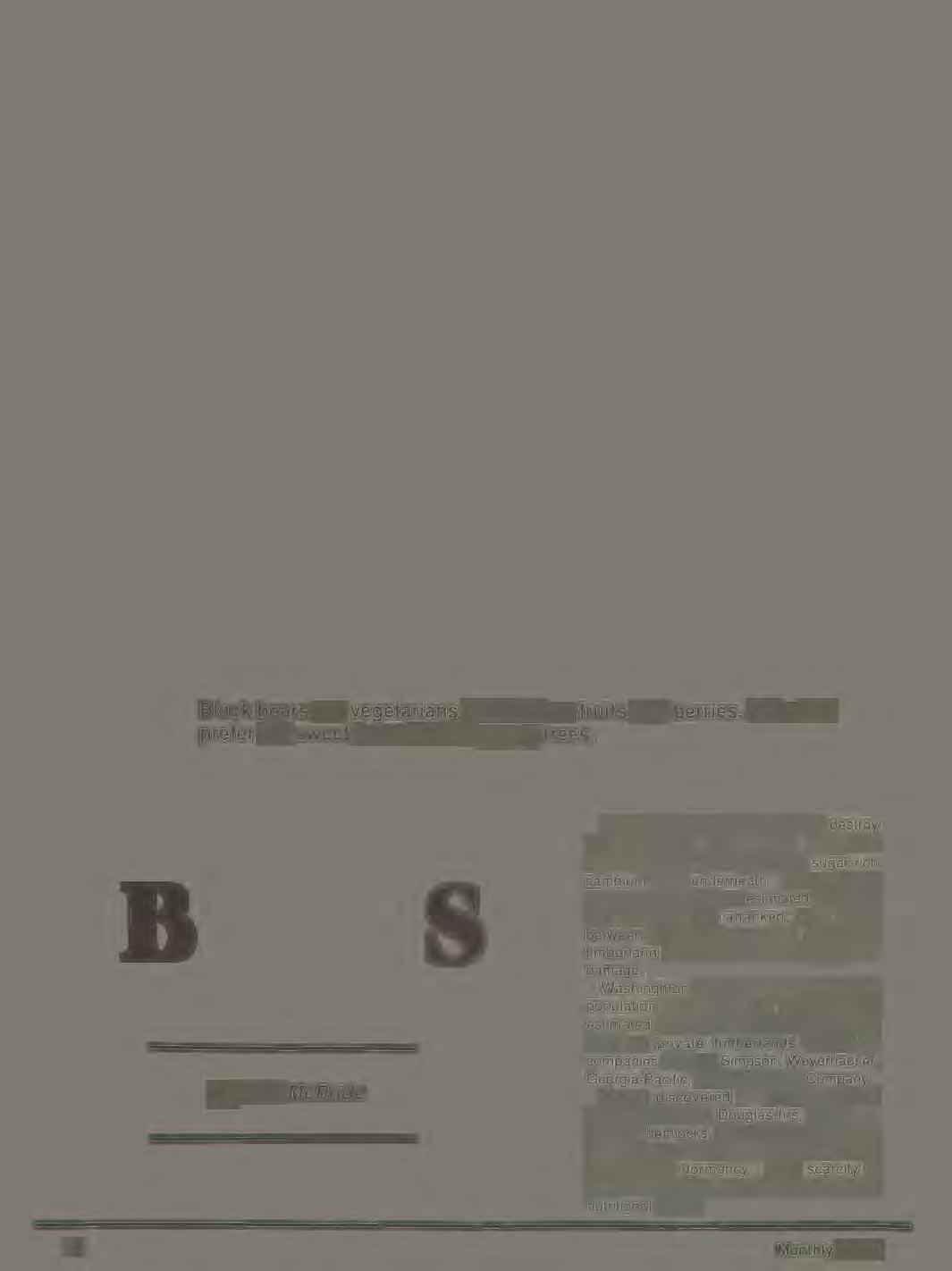 By Tom McBride
By Tom McBride
Black bears have been known to destroy 50 young trees in a single day. They claw and chew the bark to get at the sugar-rich cambium layer underneath. In an extreme case, one bear killed an estimated 700 trees. Not all trees are attacked, only those between 15 and 30 years old. Owners of timberland have taken action to stop this damage.
Washinghton has the largest black bear population in the lower 48 states with an estimated 19,000 bears. About half of them exist on private timberlands owned by companies such as Simpson, Weyerhauser, Georgia-Pacific, and Scott Paper Company.
It was discovered in 1945 that bears chewed bark from Douglas-firs, Silver firs, Western hemlocks, and Western red cedars. It only occurs in the spring when the bears come out of dormancy. With scarcity of food, the bears turn to the trees for their nutritional needs.
10
Monthly Planet
Not all black bears eat the bark of trees; this trait apparently is learned. In some areas where the forest is separated by a river, bears on one side eat tree bark, while bears on the other side don't. On Vancouver Island bears have never bothered the trees. It is believed that since the bears are isolated on the island they haven't observed other bears stripping the bark on trees.
Most of the damage in Washington occurs on the Olympic Peninsula, and in the Mount Baker-Snoqualmie National Forest. Georgia-Pacific has no apparent problems with bears, and is doing nothing to disrupt the bears in their forests.
spring. They have been successful in developing a supplemental feed for the bears. The feed, in pellet form, is distributed in 5 gallon buckets. It has an apple-pumice base with other ingredients.
Currently twelve timber companies are in the program, and another twelve show an interest. The program is still experimental with a lot of questions yet to be answered. For instance, how effective will the supplemental feed be five to ten years from now? Will this feed turn the bears into junkies that will get upset if they don't receive it? Will the bear population increase, and alter the bears natural behavior? Currently studies are being done to answer these questions So far the feeding program shows great promise; last year only one bear didn't respond. The bear, which not only ate the feed but also the trees, was removed.
"This isn't a pancacea," said Bob Dick, edible damage control program supervisor. "There still might be a need to either snare or trap a bear that doesn't respond to the feeding program."
-Bob Dick
During the 1960s timber companies hired professional hunters to remove the problem bears in areas hard hit. In the late 1970s, professional hunters no longer were needed, and the timber companies stopped using them. A new program was started with the help of the State Wildlife Department. The timber companies in early spring identified areas in their forests that were hit hard by bears. They notified the Wildlife Department, and those areas were then opened for a special two-month spring hunt. The last year for this program was 1987.
The Washington Forest Protection Association (W.F.P .A.), an organization founded 80 years ago to fight forest fires, now is a service organization for private forest land owners. It has developed a new way of dealing with the bears.
Part of this service, headed by Ralph Flowers and Bob Dick, is animal control. Three years ago, they started working on an idea of feeding the bears as a method of preventing the bears from damaging trees in the first months of
The Department of Wildlife thinks it's a step in the right direction and feels the W.F.P.A. should be commended on their efforts to work with the bears.
The U.S. Forest Service is restricted by law to use a supplemental feed program to control bears that damage the young forests. Its five year study that re-evauluates the bear situation and will be out in Febuary or March of next year.
Animal rights groups and environmental organizations have suggested to the forest service that maybe the bears don't always kill the trees, and maybe it was overlooking something. One possibility is that the bears are not causing enough damage to worry about, or maybe they are causing a lot more damage than anticipated, and some sort of damage control program is needed

If there is a need for action, the forest service will have a public hearing. Animal rights groups and environmental organizations will be allowed to work with the forest service on the damage control program.
It appears that the forest service and private timber companies are making an effort to work out this problem, and they are not making any hasty decisions. Let's hope the new report favors the bears.
'
There still might be a need to either snare or trap a bear that doesn't respond to the feeding program. '
December 1987
m Ien ". JI , 0 • H -i i OpenDaily 7:30 am - 11 pm 11th & Harris - Fairhaven GOOD FOOD, QUALITY PEOPLE, FRIENDLY PRICES 1059 N. STATE MON-SAT 9-7 SUNDAY 11-6 Everyone welcome rw;~~l I Tea and Opice I 1 8 :~:/;::: § TN Blends tl Tea Cups S § Fresh Ground Sp,ces B I 1307 Ra,,~oo;.:,,,ngham , we j~ 8 733 - 0517 98225 _., 11
PROFILE:
BRUCE BROWN
 By Ken Bennett
By Ken Bennett
On December 9, 1985, Dale Burr, a farmer in Lone Tree, Iowa, shot and killed his wife, Emily; his neighbor, Richard Goody, who recently had won a lawsuit against the Burr family; and John Hughes, president of Hills Bank and Trust. Burr then turned his gun on himself.
"I'm using that sad and dramatic incident to illustrate the social and economic plight of farmers," Bruce Brown said. "Dale Burr was a pillar in his community, and it was his indebtedness that drove him to commit this tragedy."
Brown's affinity for farms has encouraged him to write a book on the farm crises currently plaguing the Mid-West.
"In this century, we have witnessed a shift from independent, small farms to larger, corporate-owned farms. These larger farms are capital-intensive, and corporations have extracted wealth from them, but they impoverish the land in the process. They are mostly concerned with short-term profits, and that attitude leads to long-term harm."
12
'In this century, we have witnessed a shift from independent, small farms to larger, corporate-owned farms.'
-Bruce Brown
Monthly Planet
In· writing about the farm crises, Brown hopes to have a clearer sense of the issue. He has started the manuscript for the book, and he hopes to have it ready for publication in the summer of 1988.
Brown lives in Sumas, Washington, on a farm that his grandfather bought in 1924. His wife, Lane Morgan, and three year old daughter, Laurel, share his enthusiam for farm living. They share responsibilities in caring for the animals they raise, which include three young steers, one milk cow, five chickens and a pig.
"The pig's name is Bigger- 'cause that's what she keeps getting," remarked Brown as he scratched its bristly ears. "She is also a natural roto-tiller." The fresh ruts that the pig had routed confirmed his observation.
Brown has been a professional writer in the Pacific Northwest since the mid-1970s. His first book, Mountain in the Clouds, published in 1982, is a historical account of the Pacific salmon runs. In the book, Brown balances his narrative with personal experience and historical fact to illustrate the significance of salmon in the Pacific Northwest. The popularity of the book prompted its publisher, Simon and Schuster, to nominate it for the Pulitzer Prize.
Born December 30, 1950, in Seattle, Brown attended public schools in the city. Upon graduating from high school in 1969, he enrolled at the University of Washington. He later moved to the East Coast, and
studied at Oberlin College in Ohio. Returning to Seattle in the 1970s, Brown became editor of Argus Magazine. His interest in the fishing industry developed as a result of stories he covered while working as a reporter for the Seattle Post-lntellingencer. He left the newspaper in July of 1979 to write Mountain in the Clouds.
lounging comfortably in front of a warm fireplace, Brown contemplates his next assignment as a naturalist writer.
"I'm writing the script for a Public Broadcast Service presentation entitled, 'Miracle Planet,'" Brown said. He was hired by Seattle's KCTS Channel 9 to condense the documentary into a 6-part series for American public television.
"It is an earth-science documentary that originated in Japan as a 12-part series on their national television network, " he said.
He expects the series will broadcast in early 1989.
 Rosie, a Jersey cow, keeps Bruce Brown and his family supplied with milk.
Rosie, a Jersey cow, keeps Bruce Brown and his family supplied with milk.
December 1987
'The pig's name is Bigger--'cause that what she keeps getting.'
-Bruce Brown
13
Chloro-fluorocarbons in the atmosphere
By Jim Wiggins
At some point in our lives, chloro-fluorocarbon (CFC), expanded polystyrene, ozone, ultra-violet radiation and a cup of coffee will play an important role in our future.
Perhaps they already have.
Polystyrene, also known as "Styrofoam", and the CFCs used to produce styrofoam, aff act a layer of the atmosphere, the ozone, which reduces ultra-violet radiation.
The sun, a giant nuclear fusion reactor, gives life to the earth through energy which plants convert to carbohydrates. The plants in turn are consumed by other living creatures.
ultra-violet radiation hitting the earth has also been shown to reduce crop yields and is suspected to affect the health of trees.
In 1978, the U.S. produced a ban on the use of CFC's as an aerosol propellant. On Sept. 16, 46 nations met in Canada to adopt a treaty pledging to cut the use of CFC's by 50 percent.
Despite the ban, the use of F.,FC's is increasing. Many Third World countries do not recognize this treaty and many industries do not recognize CFC's as a threat to the enviroment.
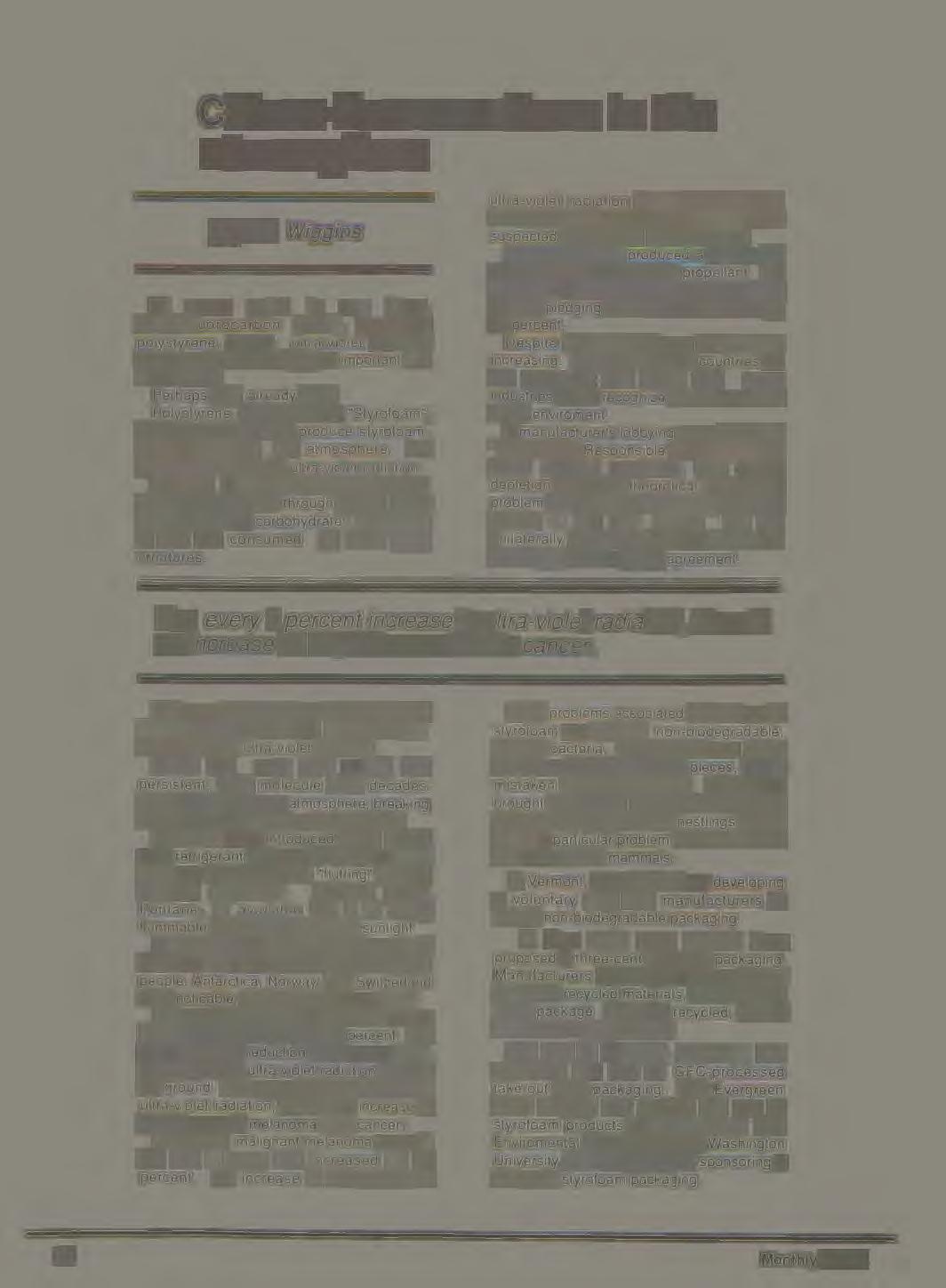
A manufacturer's lobbying group called the " Alliance for Responsible CFC Policy" has taken several positions; that ozone depletion by CFC is theoretical; if there is a problem with CFC, there is plenty of time to correct it; the U.S. should not act unilaterally to reduce CFC emissions but should only act on a global agreement.
The sun also sends to the earth other forms of energy which are harmful to life. One of these is ultra-violet radiation.
CFC's are very light weight and persistent; each molecule lasts decades. They float in the upper atmosphere, breaking down the ozone layer in a chain reaction.
CFC's first were introduced in the 1930's as a refrigerant and are still used as such. They are also used as the "fluffing" agent to produce styrofoam. Another agent, Pentane, is available but it is highly flammable and oxidizes quickly in sunlight.
It is the use of CFC's and the resultant effect on the ozone which concerns many people. Antarctica, Norway, and Switzerland have noticable "holes" in their ozone layer.
The use of CFC's has reduced the ozone layer in the last 10 years by 7.5 percent. For every 1 percent reduction in the ozone layer, 2 percent of the ultra-violet radiation reaches the ground. For every 1 percent increase in ultra-violet radiation, there is an increase of 30,000 cases of melanoma (skin cancer).
The rate of malignant melanoma cases in the last 7 years has increased by 83 percent. An increase in the amount of
Other problems associated with the use of styrofoam are that it is non-biodegradable, harbors bacteria, emits toxic fumes when burned or broken into small pieces, and is mistaken for food by birds. Pieces are brought back to the nest by adult birds and fed to their young, thus the nestlings starve. This is a particular problem with marine birds and some marine mammals.
In Vermont, state officials are developing a voluntary plan with manufacturers to reduce non-biodegradable packaging.
In New York, state officials have proposed a three-cent tax on all packaging. Manufacturers would get a penny back if they used recycled materials, another penny if the package could be recycled, and all three cents if they did both.
The City of Berkeley, California, has prohibited the use of CFC-processed take-out food packaging. The Evergreen State College has banned the use of styrofoam products on their campus. The Enviromental Center of Western Washington University is in the process of sponsoring a ban on all styrofoam packaging.
14
For every 1 percent increase in ultra-violet radiation, there is an increase of 30,000 cases of skin cancer.
Monthly Planet
LOW WATER: Fall salmon run aground
 By Mike Monson
By Mike Monson
Rainfall is usual at this time of year. This year, however, has been unusually dry. The drought has been felt throughout Puget Sound and the Northwest which, in one way or another, relies on a moderate to heavy rainfall.
Strict measures have been taken to protect the state's resources against the drought. National forests have been closed because of fire danger, water conservation was put into effect, and some fish, unable to get upstream to spawn, were transplanted.
The fish have more than one problem. Not only lack of water, but the problems that a lack of water causes. Spawning fish need enough space in a stream or river to successfully carry out the spawning process.
Because of the drought, less streams and tributaries are available for the fish, and water levels are lower in the remaining waterways. The fish can sense that the flow of a stream is insufficient for their needs, and many will not even attempt to enter the stream if the conditions are not right.
The fish that choose to enter the "spawning grounds" do so at some risk. The reduced flow of a stream or river, tresults in crowding. The fish need room to roam in the streams in order to find a proper place to deposit their eggs, and they need room for their natural freedom.
Without this room the fish will not spawn, or serveral fish may spawn at the same location, referred to as superimposition. This creates a layer of eggs over another layer greatly reducing the chances of survival for those eggs.
Crowded streams have the risk of oxygen depletion. Since water can only hold a certain amount of dissolved oxygen, and fish need a certain amount to live, there has to be enough water, per fish, to sustain the population. In crowded streams there may be a large enough fish population to deplete the
level of oxygen sufficiently to cause suffocation.
Predation is a problem for the fish that enter the rivers, and those that choose not to as well. Those that do not enter the rivers compete with a greater amount of sea life for food, and are themselves food for larger sea-going animals such as seals.sea lions, orcas.
Those that enter, face the low water exposing them to land predators (dogs, bears, humans). During times of low water flow, sometimes no choice is right.
Water temperature also affects the health of the fish. When rainfall is low, the temperature of the water tends to rise. Warmer water decreases the ability of water to hold oxygen, reducing the health of the fish population.
Lower levels of water tend to increase the percentage of toxins in the water, and reduces their dispersal.
If the water level is low enough to leave or create a pool there is a danger of an rise in temperature, stagnation, and disease. Eggs already deposited may be exposed to the air and dried out.
Although these problems are devastating to the fish population, the
final effects of the drought cannot be assessed until the eggs hatch and leave the streams.
Not just salmon are affected by the drought, but also Steelhead, Dolly varden, and other species of trout. Much attention has been given to the salmon, however, because the salmon fishery is a large industry in the Pacific Northwest.
Hatchery salmon probably will be the least affected fish. To have a successful year, the hatchery return needs to exceed 10 percent.
The wild salmon are different. It is important that at least 50 percent of the fish return. The valuable gene pool associated with the wild salmon must be maintained.
Since this is a brood year, or a returning year for spawning fish, it is important that great care and consideration be taken to maintain the proper amount of return.
The recent rains have helped the condition of the streams as far as water level, but it will take quite a bit more to put things back to normal.
December 1987
This year's drought is the worst in Washington history.
15
Low rainfall
threatens wildlife
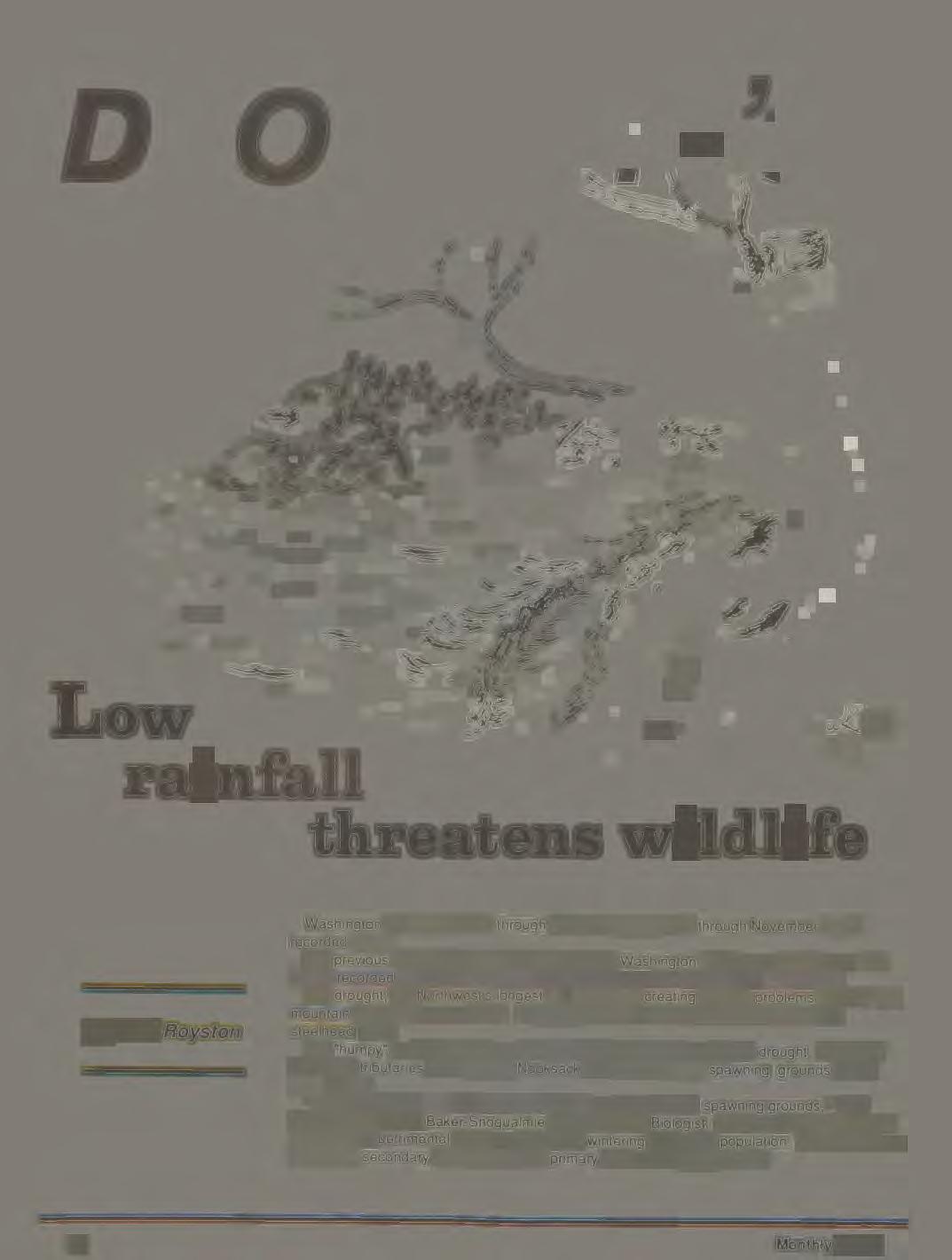
Washington has just suffered through the driest period, June through November 1st, in recorded history.
The previous official low rainfall total for Western Washington in the same period was 1.90 inches recorded in 1895. This year's total for the same five months was 1. 77 inches.
By Rich Royston
The drought, the Northwest's longest in a century, is creating serious problems for deer, elk, mountain goats and swans. and it is raising havoc on the fall and winter salmon and steelhead runs.
The "humpy", or Pink salmon run has just about been wiped out by the drought. The lower end of the tributaries of the Skagit, Nooksack and Samish rivers, spawning grounds for the pink, are dry.
" The Pinks have just died because there is no water for the spawning grounds, " said Brady Green, Mount Baker-Snoqualmie National Forest Biologist. The loss of the pink salmon could have a detrimental effect on the state's wintering bald eagle population. Pink salmon are the eagles secondary food source, their primary food source being Cohos.
......____
16
Monthly Planet
Chinook salmon should be spawning now but they have also been aff acted by the low water, Biologists say. "Some Chinook can spawn in large rivers, but the ripple areas where the Chinook spawn may be dry thus impacting them also. " Green said
Junior Coho, Silvers, and Steelhead remain in the spawning grounds for up to a year before moving out to sea. A recent survey showed that they have been wiped out by the drought. The fingerlings hatched after last spring's salmon runs have also been wiped out. Green estimated that the Northwest fisheries would be severly impacted for the next four or five years.
be enough returning Chum, if the rains do not begin soon. Bald eagles will be severly affected by a poor Chum salmon run.
Alpine meadows, the natural food source and water source for deer, elk, and mountain goats are drying out, causing these animals to move great distances to seek other food and water supplies. Forest Service biologists suspect the drying of the alpine meadows to be responsible for an increasing mortality rate among these species, although they do not have specific numbers of the larger animals affected by the drought.
A recent survey shows several ponds and sloughs, which are used as overnight resting places by wintering trumpeter swans, are mud holes. The swans rest on open water at night to avoid predators. They are expected to arrive in the Skagit Valley in the next few weeks.
Lee Krough, a National Ocean and Atmospheric hydrologist at Sand Point Naval Station, said Washington's prosperous commercial and recreational fishing industries are being dealt a severe blow.
The Fraser River in British Columbia, one of Canada's major rivers for salmon spawning, is also experiencing the harsh effects of the drought.
But the drought is also affecting other areas of the enviroment as well. The region's eagle population should have an abundance of Chum salmon carcasses to feed on. Brady Green believes there should be enough water in area rivers for the Chum Salmon to begin their run in late November. Two years from now, however, there may not

The swan population will reach its peak at the end of November and the first part of December. Their winter food supply, however, has been greatly reduced by the drought. The Washington State Department of Wildlife is closely monitoring the swans feeding. Artificial feeding may be used later in the winter to prevent large scale starvation.
Natural and mechanical revegetation projects on forest lands are in danger of being lost. This is having an immediate effect on the small wildlife, squirrels, birds, and other animals that feed on the fallen seeds, cones and tender young tree branches.
The long term effects of this record drought on the Northwest's lumbering industry is unknown. It is believed, however, that there will be fewer trees to harvest as the younger trees become stressed by the lack of moisture.
This year's drought has put a severe strain on the enviroment of the Northwest.
'The Pinks have just died because there is no water for the spawning grounds.'
-Brady Green
HENDERSON BOOKS WE PAV CASH FOR BOOKS Hardcover and Paperbook 306 W. CHAMPION BELLINGHAM 734-6855
r ....... ........,~.......~..-0,-1 I BEECH HOUSE PUB I 8 § 8 Wide Screen "~ 8 8 T.V. 8 8 . , R Kegs to go 1_ .-'\-. § § § 113 E. Magnolia M I Bellingham I S 733-3331 1005 Donn J t3arr Wines • ~lens • Gifts Fairhaven Pkwy and 12th Open Mon-Sat 1O:OO-s:oo 7 17
Georgia-Pacific
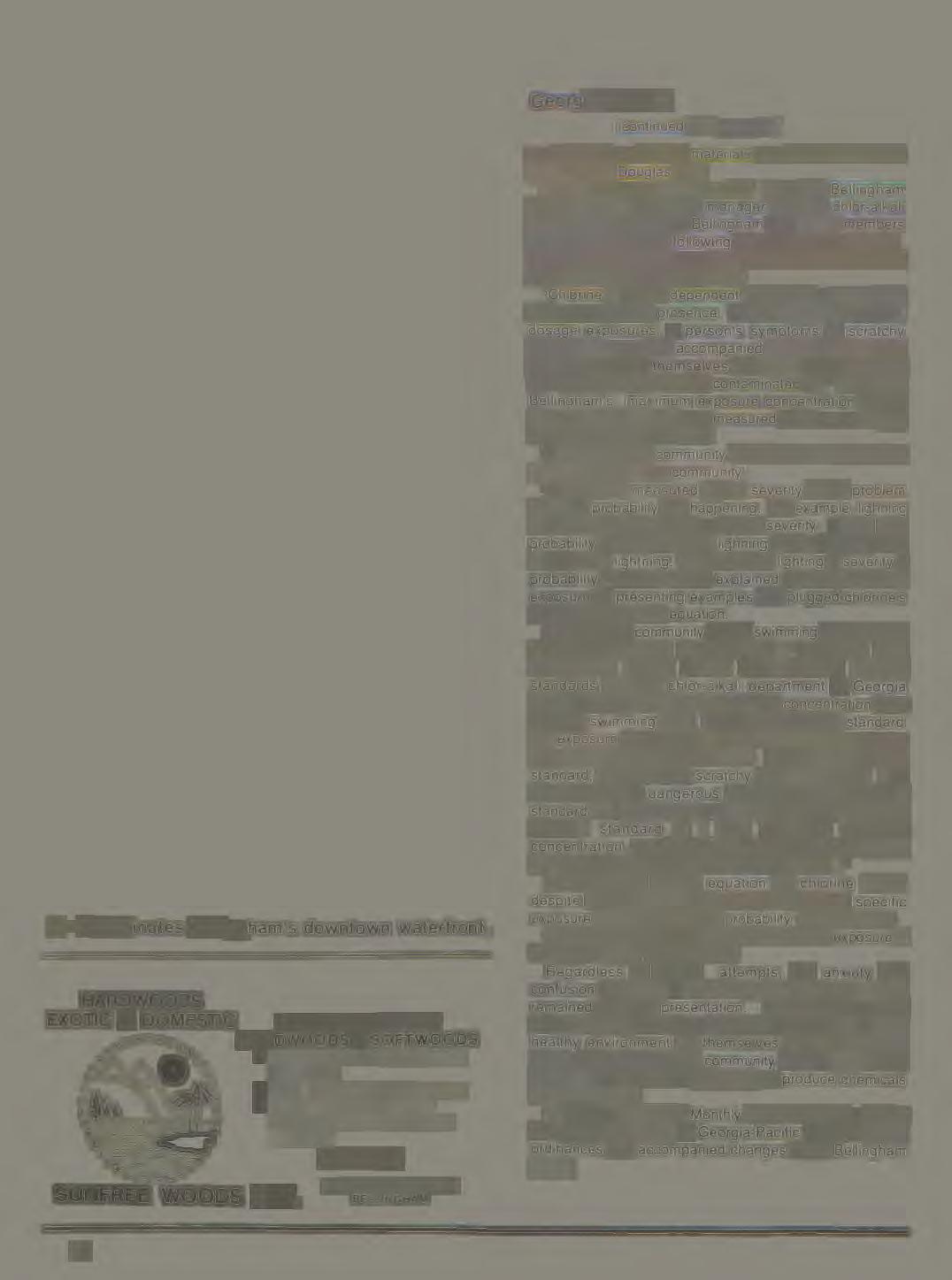
(continued from page 5 )
our attention on how all materials are handled within the plant." Mayor Douglas said.
During an open forum on Nov. 2, at the Bellingham Public Library, Don Elliot, manager of G-P's chlor-alkali plant, spoke to about 50 Bellingham community members about their concerns following the gas leak on Oct. 19. Elliot said his intention was to raise the comfort level about what chlorine is and what it is not.
"Chlorine is a dose dependent irritant with a strong odor that warns us of its presence. At acute (brief and severe) dosage exposures, a person's symptoms of scratchy and/or blury eyes with accompanied pain in the throat and chest will reverse themselves with time, once the victim has been removed from the contaminated air," Elliot said. Bellingham's maximum exposure concentration of one part per milliliter (I ppm) was measured at the corner of Bay and Holly streets, he added.
A member of the community asked about the hazards of having chlorine in our community.
"A hazard is measured by the severity of the problem times the probability of it happening. For example, lighning is an obvious hazard with a level of severity. It kills. The probability of being struck by lighning is low, 16 people died in 1986 from lightning. The hazard of lighting = severity x probability," Elliot said. He explained the health risks o1 exposure by presenting examples that plugged chlorine's hazard level into this equation.
"The average community YMCA swimming pool contains 0.25 ppm of chlorine. You can smell it," Elliot said. "The Ocupational Safety Health Administration (OSHA; standards limit the chlor-alkali department at Georgia Pacific to I ppm. This is four times the concentration of an average swimming pool. At 25 times OSHA's standard, the exposure of 25 ppm for a short duration may cause your lungs and/or throat to hurt. At 60 times OSHA's standard, you will have scratchy and blurry eyes. You have reached a dangerous level at 100 times OSHA's standard for a duration of one hour or more. At 1,000 times OSHA's standard of I ppm maximum exposure concentration, you have reached an LO 50/50 (lethal dose, where 50% of lab animals will not survive)."
Elliot said the hazard equation for chlorine is low, despite the the high level of health risks at specific exposure levels, because the probability variable is low.
"There have been zero deaths from chlorine exposure in the past II years," Elliot claimed.
Regardless of Elliot's attempts, the anxiety and confusion of having a chlorine plant within the city still remained after the presentation. People want to know what it is going to take to have their concerns for a safe, healthy environment for themselves and their families heard. The people of this community have a right to feel safe, just as G-P has a legal right to produce chemicals within their plant.
[In the next issue, the Monthly Planet will take a look at the governing history of Georgia-Pacific and the zoning ordinances that accompanied changes at the Bellingham plant.]
G- P dominates Bellingham's downtown waterfront. HARDWOODS EXOTIC & DOMESTIC A WIDE VARIETY OF HARDWOODS & SOFTWOODS • CUSTOM RESAWING OF LOGS & LUMBER • BOAT & INSTRUMENT WOODS • SPECIALIZING IN "HARDWOODS TO GET" FOR OVER 10 YEARS 671-8123 SUNFREE WOODS LTD. 219 PROSPECT STREET BELLINGHAM 18
Endangered
0pec1es
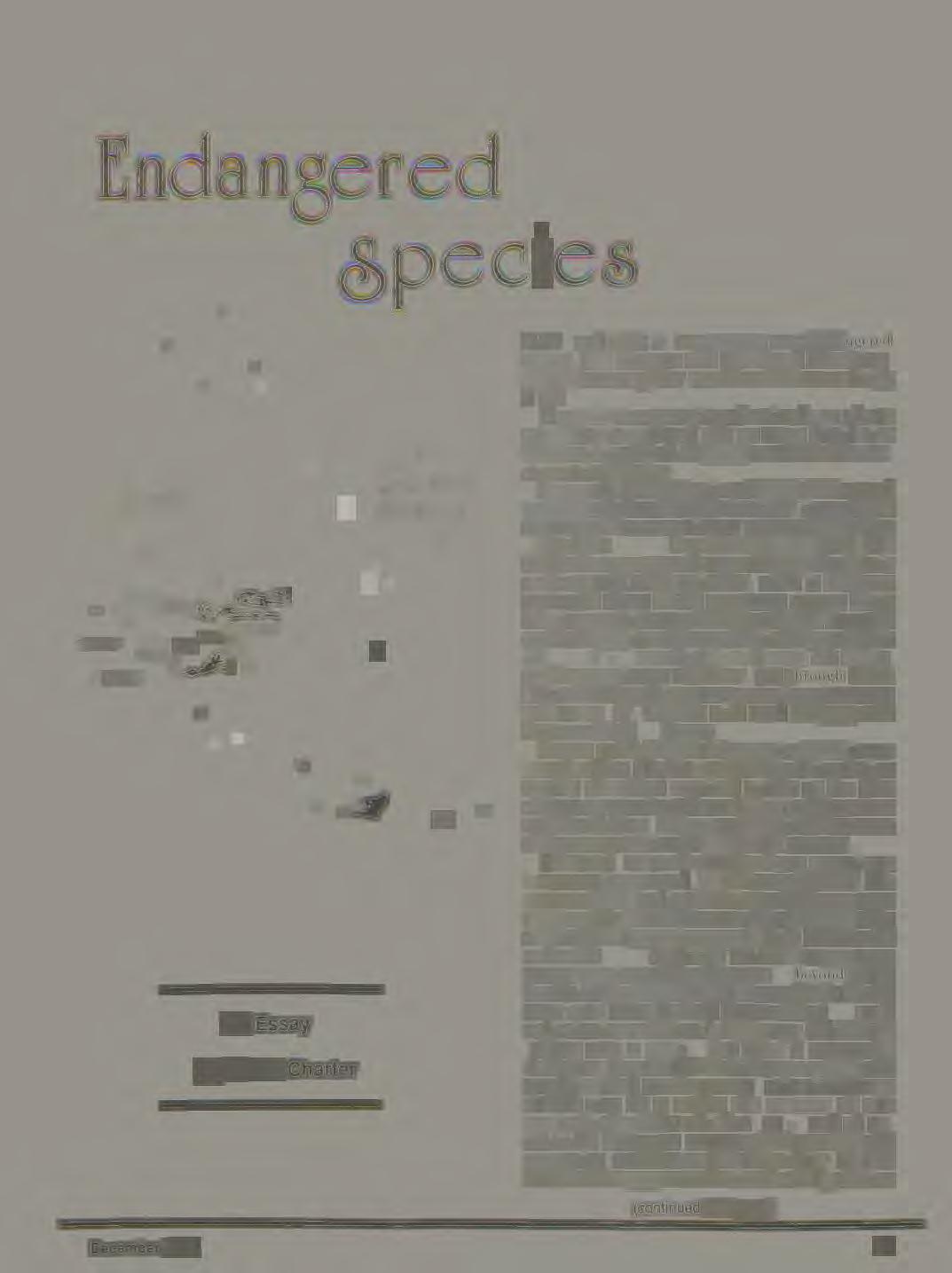
\\'HY •rnd what is. our concern over endangered spec_ ics ? The dinosaur and pterodactyl have di appc.Hcd f,om our planet, yet we arc here on our living Earth , \ -,pecie is a g1ouping ,of animal or plants posse s1 ng in common one or more di tinctive cha ran en tic and which reprodu e the e characteri tit in it off pring. pcries which become c tinct throu h tho e natural prnccsse ,,hich make them non - viable, in apablc of sustainmg their own ontinuum, ar not thou ht of as b•·ing endangered for what endangered them? We think of a pecie as being ndanger d when it confronts man - made extinction, when it confront man - made threat of the perman nt ra urc of it life-gi, ing continuum extending unbroken from th pre cnt to deep imo the rccc e of it. hi tor whi h i
gered pc ie is one which we, not throu h dire t enmity but through ignoranc or avari e or ontempt r:nd 11nconcem. threaten with total di app a ran from our Earth fo1 \' f. ' numu:rn has become the prot tive d vice in our omplcx Man l\.1achine world for If - in ulation against the ('ffort requir d within u for that continuous commitment to our life -giving human n without whi h we endanger ourselves in the mom nt and our ov.:n continuum beyond the moment.
An Essay
By S.P.R. Charter
The total erasure from life of any organism' ontinuum is ver · nearly be ·ond ompr h n ion. W can more r<'adil · realise the ·xtin tion and permanent irrcpla< ea bi lit of the dinosaur and pterodactyl than w • can that of any sp ie pr ·sent! · alive. Wh •n w do reali.,c· that people now living <an indeed impos upon an entire sp<·< i<·s su< h disappearance be ond return for all tim<· regardless of even the most dedi at d and most con entrat cl of all human ·ffort u h realisation is extraordinaril · fright ning. Dcliberat I endangering a 'iJ)C ies g<·nerates a man - made disharmon · toward all lif<· which torsions hop· • nd amplifies the ft-a, of our own extinction alwa · s mo u I d <' r i n d c <' p w i t hi n th r<' n s es of o u 1 spc ies - hi tor from whi< h we arc, ·ach of u indivisible. nconcnn, no matter how encrusted and pnnwating , cannot <"rasc this indivisibility. \ ithet can the most expert rationalisation for the liqu1<lation
•
t • 1r"' ' , I I I, Ill, I 11'1 111 ---v:-; cl'(..;"';,: . .---· · -. --"· '/1/. ; :-- =p· ~r- : ' •: • I
December 1987
(continued
19
next page)
of a species in the name of 'human superiority ' and 'human need' erase this indivisibility which, for us, is more than only biological. It is also organic to our actual and emotional / spiritual humaneness without which we can no longer evolve No organism can sustain disharmony within itself , and evolve; it can on I y devolve Our disharmonious devices for de s tructivenes'i , inundating our need for constructiveness , a cc elerate our devolvement.
It is p1ecisely here within the context of endangered sp<'< ies , that we confront the multiple nuances of the question , intimately significant to each of us , of the inte1 rclatiomhip of the natural and the man mad<' It is also precisely here that we can begin to grasp the imp:>rtarH , ol ! h• · questi, ~n ,0 vita! tr, u s : v\ ' h ,i: i •· Man 's ' place' in all of ature? We cannot ever escape from this vitalness. Through our enormous technological capability for destruction and construction we have mad<.' this question more than only theoretical. Our continuum surely depends upon this one o; many questions ; our present lives also do , and in innumerably suhtle ways Can anyone of even the most passing concern over endangered species reject this question to himself?
1 hose of concern who declare , in e\en the most earnest egalitarian goodwill, that Man i. only anothe1 species with no more ' rights' to live on the planet than any other spe ies. avoid this question to the detriment of all endangered species , including Man. They den\ the human capability and evolvement, and respomi bility Such egalitarian goodwill is equivalent to saying that 'we must save the whale because it is o massive and intelligent' and , thereby , like us . What of species neither ·massive nor intelligent' to us? What of people who are neither 'massive nor intelligent' to the power -controllers?
Of c our s:.- ·,•.c shoald att - ;";"lpt ~;:; ::: a·.c ~h - ·:.~ale , .- c ~ if we fail , and for reasons beyond the whale's intelligence. In our attempts to save an endangered species we come ever closer to the roots of the question of our own place in all of ature. It is these root among others, which intertwine us with all of ' atu1e
In its man - made endangerment, the whale indeed beautiful, massive, intelligent, and as we now know, fragile in its future - crie to us from the depths of the fragile oceans in haunting refrain for ail man -endangered specie including man -endangered Man , an<l for man -endangered Earth And our inne1 translation of this cry penetrates us more deeplv than does the ry of the man -endangered child entwined in man - made war and living in man - made rubbk urrounded by man -mad destruction of life -giving areas of our indivi ible Earth Even to those concerned with endangered spe ie who respond to both cries there is a qualitative diff rencc between the two and the difference is profoundly , albeit di comfortingly significant to us . Is the child more expendable than the whale? I s the anonymous child to u · only part of
the abstraction we call 'mankind , ' while the anonymous whale is not an abstraction to us but demonstrably representative of a tangible endangered species ? Yet, when we bring the anonymous child to our individual thought , that child is, to us in that moment , abstracted from the abstraction of 'mankind ' and becomes to us an individual - which the endangered whale , even in our deepest thought , does not. Even then , the child ' s cry does not penetrate us more deeply than the whale ' s. Do we believe that the whale is less expendable to us than is the child because the child ' s replaceability in terms of numbers makes him less vital to us than the endangered whale and its irreplaceability ? Do we believe that ' ature 'requires' th<' whale more than it <loes the child? Nature , quite evident\\, , did not ' 1equire ' the dinosaur anci ptc-rodactvl. Wh y should it now 'require ' the whale or the child ?
' l lwrc j.., a most ,ignif:c ,1111 qu.tlitat1\.c diff<-1t·nn· 10 u-.; in ou1 inner t1,u1slarion aad 1cspon-.;e to the cry of tlw endanKt'lTd whale and I ht· ny of th<' t'ndangercd d1ild

In dw cnclangnt'd wh,dc\ nv . those of us (apable ol in11t 1 ht'...1ring h( .ir t'Chocd our own crv to know our l)\\ 11 111t ,tning and LO attt tnp1 tu lt·,1rn somt'thing of our pl.HT in N,Hurc u •lu'c/1 u •(· a/J/Hircntlv and obr 1z'owly clo not wt knoll'. The t·11<la11gc1ed child's cry is an indictment ol us because co the child we do know our me.ming ,rnd purpose toward him : it is all too evident 10 hilll and tu us if our vision is not self-delusional. \\'c m.1\ 1cjcn chc indic.tnwnt of the man -encianger<'d t hild l'\ en ,,., we do not wish to reject the cry of the t·1HL111gercd v.h.dt· prcciselv ht cau e the factors of 1q1l,1ce,1bilil\ and irreplaccability. as we know rhem to lH · t l , u:- du n !tu v.id1i11 w,. vVc mtty believe that , :-.unwhn\\. \\C' m ,1v be ablt· to compensate for one child UY grc.uer concern <.'Ver another child . But we know deep within us that the whale , once extinct , gives us no rh .11Hr wharsoc\'cr for self absolution over our m.in made extinction It is when we <lo attempt to \.. nuw our mt'aning and to learn something of our place in '.\:,1tu1T that we will then hear both child and whale , and know their indivisibility Does this attempt become more focu ed to us r hrough the endangered wh,de than through the endangered child? It would
The rnm '.\:ature , a it is u ed here , refers to the multipl icit y of interrelationships existing on our living Ea1 th \, hich through its life -giving quality , is more than onlv a life - upporting spaceship. ( The reader is referred to THE PLA ' NL G MYTH, in which this 1,pect is di:-( m~ed in ome detail.)
ben though Man i forever part of ature and n \ ' Cr apart from Nature there is a distinction of basic :-iig nifiL,lri CL bct\H en the nalural and the man -made \,·hi h we need to realise if we are indeed to attempt to
20
Monthly Planet
under tand our place in Nature. This distinction is both gros and subtle in its implications. Resurrection is ·natural' for Nature: for Man-the-Individual it is not natural. He needs to nurture within himself his own capabilities for resurrection. Of course Man is part of Nature; but Man-the-Species is a more organic part than is Man-the-Individual - who is always impositional upon Nature.
During the aeons of pre-Man Nature, Nature was not imposed upon by any organism in terms of the organism's future gain. In ature there is a symbiotic necessity within a constant is-ness, a constant present. Imposition for future, projectability toward future whether near or distant, whether for good or ill - is uniquely a human quality. While our capability for projection toward future is a gift quite literally priceless, in our Universe we get nothing for nothing and there is indeed some cost we pay, and pa.y continuously, for this gift. The cost we pay is the impositional quality we exert upon Nature precisely b cau.:,c we are indeed capable of forcthuught for good or ill. And it is a cost we pay in the coin-of-self of which wt" need to be more aware and concerned than we are.
The man - made is always impositional upon Nature whether this imposition is for the 'good' as in forest replanting. or for the 'bad' as in forest decimation. The man-made imposition is always for the purpose of either short-range or long·range projected gain to the imposer and to those toward whom he may feel some responsibility. The imposer may consider himself to be the most important part of ature to whom all other paw, are sub ervient; or he may not consider himself at all , in any sort of relationship with ature.
Capable of projection toward future, we cannot be anything but impositional even in beneficence. We con tantly impose our projective capability upon I-..1r1h\ <ornpkx i111nrelr1tiomhip::. even in the best of our ( onsu u< ts We cannot he non impositional upon aturc and remain human beings capable of forcthoug-ht, of future, of evolvrment, of hope itself.
Rc,ilising that we are inevitablv impositional upon ,tllll<' pr<''><'nts us with the profound obligation and challenge to aucrnpt, within ou1 impositions , to lw mor<' harmonious than dis or<lant. more ymhiotic than dominant. We ,an never att<'mpt to be 'free· without attempting, as a way -of life , to fulfill thi ohliga tion
Can W<' be, simultaneously, irnpositional ,ind more harmonious than dis((ndant with and toward 'aturr? Perhaps we l an if we a::.sume responsibility for our impositiom . But not in a custodial manner toward ature which does not need a cu todian, a caretaker. lL is Md11 who JH' cds to be die LUSto<lian of hirmelf d"> part of aturc-. When he assumes toward , 'ature <1n egalitarian pose he anthropornorphises ' ature: he ascribes human characteristics to what i not human Anthropomorphising is indeed a subtle form of
domination and interference; we seek, consciously or not, to dominate and interfere with that to which we ascribe our own characteristics, whether in terms of Deity or dolphins.
Is it truly only the endangerment of the whale which we lament, or is it also the endangerment of forethought, future, hope, humaneness, manifest by the impositions of the killers of the whale and the threateners of extinction who are not devils but human beings? We cannot live harmoniously with ature until we can live harmoniously with ourselves. How can we live harmoniously with the threateners of extinction?
The symbiotic necessity for us to be more harmonious than discordant is evident all about us. magnified by our expanding technological capabilities for both destruction and construction. This need is .rn expanding responsibility and hallenge worthy of the best of our present and evolving capabilitie and potentialities. If and when we evolve into this process of responsibility and challenge, rather than continue aiming for the products, the rewards, of imposition, we will then be able to possess the capability for many things presently beyond our capability. If and when we seek to be within an ongoing process of symbiotic necessity with all of Nature we will then be capable not only of removing danger to species but indeed be capable of enhancing species, including our own, and of enhancing our lives in the moment and for beyond the moment.
If our impositions are mainly discordant with and toward ature we will then ha ten the- whale to it extinction, and us to our
Is there yet time to save the whale? Pc-rhaps. thereyet more time to save ours<.>lve ? Perhaps. The indivisibility here is that in our attempt to save the whale because of our ymbioti nece. sity and conscious awareness of our impositional relationship with • 1 aturc, we cxtcn<l our time to s;.ivc ea:sel·.res th:ough burgeoning knowledge of our place in Nature, and the whale's place. The indivi ibility here. al o, is that if we do not attempt to ave the whale we foreshorten our time to save ourselves. Again, and evermore again, the question rise - before u , more in exhilaration than a barrier: What are we aving ourselves for? What is our purpose'? What is Man for?
Awarencs of the multiple implication · of endangered species hones our need and evolving capabilit, to know our purpose and our place in all of Nature, which we do not yet know but which we must eek to know. And thi is the vitalne s the biological vitalness to us. now of all endangered species, inrludin1,{ ou, own.
.PRC
Reprinted by permission of the center for human ecology/appropriate technology.

December 1987
21
BRIEFS
Move against Styrofoam
The Enviromental Center is asking people to bring their own coffee cup to campus. When ordering food, ask for paper instead of styrofoam. "A paper cup costs only a few pennies more and paper plates cost less than styrofoam." said Jim Wiggins, coordinator of the Enviromental Center. "Although these few actions will not appreciably reduce the loss of the ozone, they allow us to be heard by others, letting them know that we care. We must learn to reduce, reuse, and recycle," Wiggins said.
Initiative 97
Initiative 97 petitions are circulating throughout campus. If you are a registered voter and care about what is being done with our toxic wastes, please find a petition and sign it in order that Initiative 97 can go on the ballot.
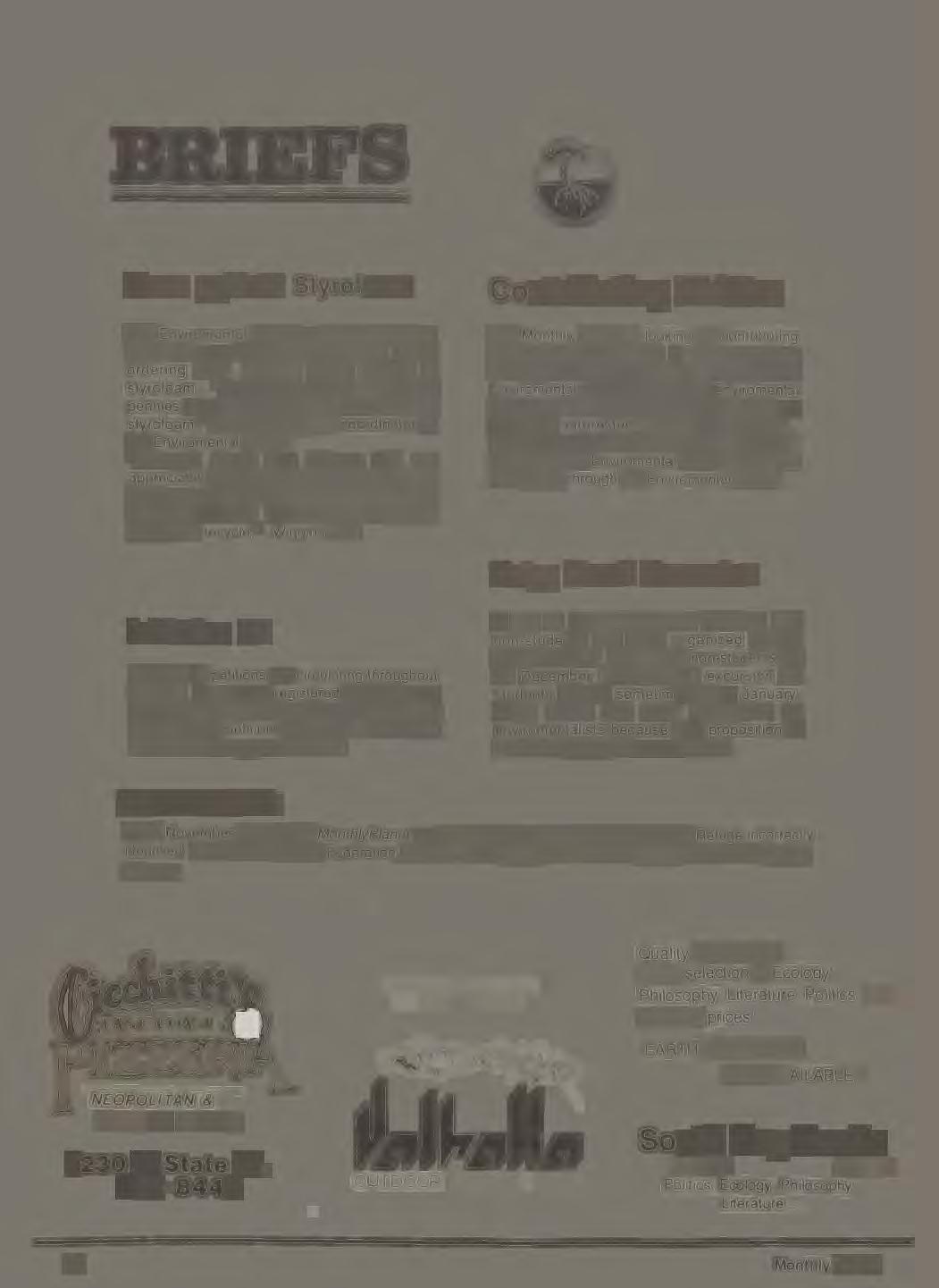
Contributing Writers
The Monthly Planet is looking for contributing writers for future editions. If you, or someone that you know has an interest in writing about Enviromental issues or has taken Enviromental classes in which papers have been written, we would be interested in hearing from you. Please send all submissions to The Monthly Planet c/o The Enviromental Center, or contact Erin Wright through the Enviromental Center.
Noisy Creek Excursion
A trip to Noisy Creek for students and non-students has been organized by the Outdoor Center. The trip for non-students will be December 12th and the excursion for students will be sometime during January. Noisy Creek has been highlighted by enviromentalists because of a proposition to cut the old growth for use as lumber.
CORRECTION:
In the November issue of the MonthlyP/anet an article about the Arctic National Wildlife Refuge incorrectly identified the National Wildlife Federation, the author of a report on the wildlife refuge. The Planet regrets the error. NEOPOLITAN & SICILIAN PIZZAS COME CHECK IT OUT! vu 104 ~7~ 3112. Quality Used Books Large selection of Ecology, Philosophy, Literature, Politics. ect.. at lowest prices EARTH FIRST ITEMS NOW AVAILABLE! South Bay Books 1230 N. State St .. 671-8447 -~'~""" OUTDOOR RENTAL SHOP 12th & Mill 647-1747 Politics, Ecology, Philosophy, Literature 22 Monthly Planet
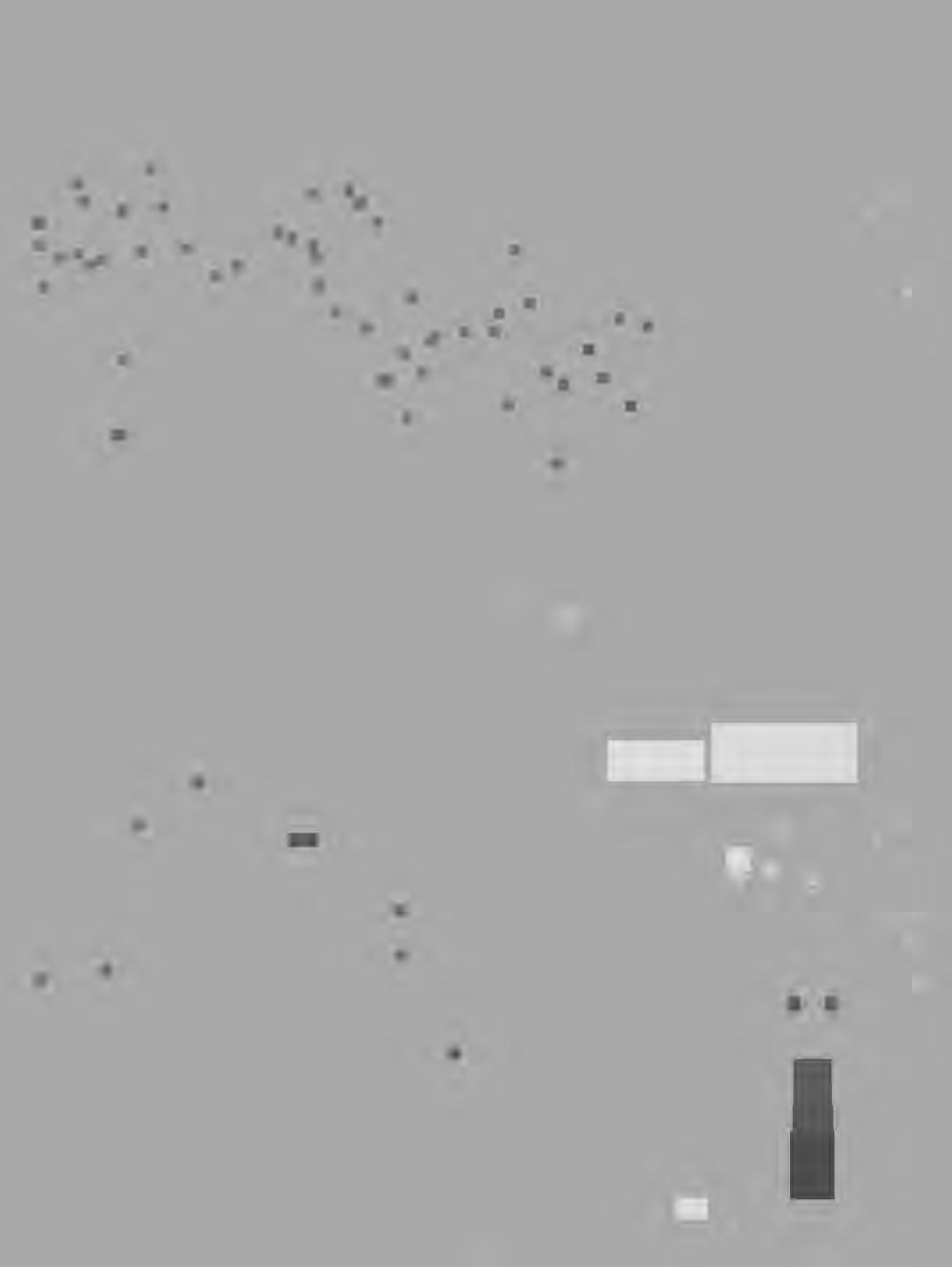


 TheMonthly Planet is published bi-quarterly by the Associated Students Environmental Center at Western Washington University, Bellingham, WA.
TheMonthly Planet is published bi-quarterly by the Associated Students Environmental Center at Western Washington University, Bellingham, WA.








 By Tom McBride
By Tom McBride

 By Ken Bennett
By Ken Bennett
 Rosie, a Jersey cow, keeps Bruce Brown and his family supplied with milk.
Rosie, a Jersey cow, keeps Bruce Brown and his family supplied with milk.

 By Mike Monson
By Mike Monson








